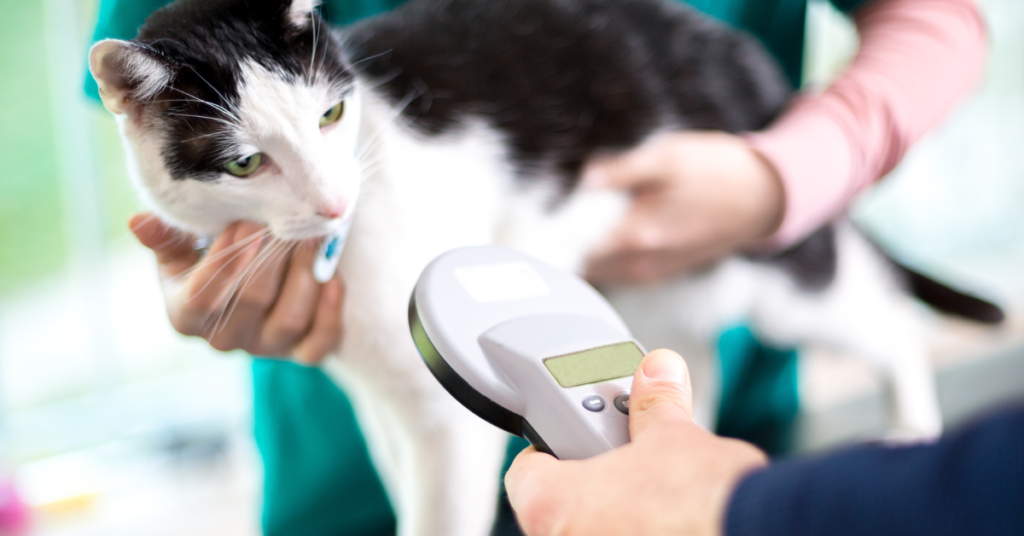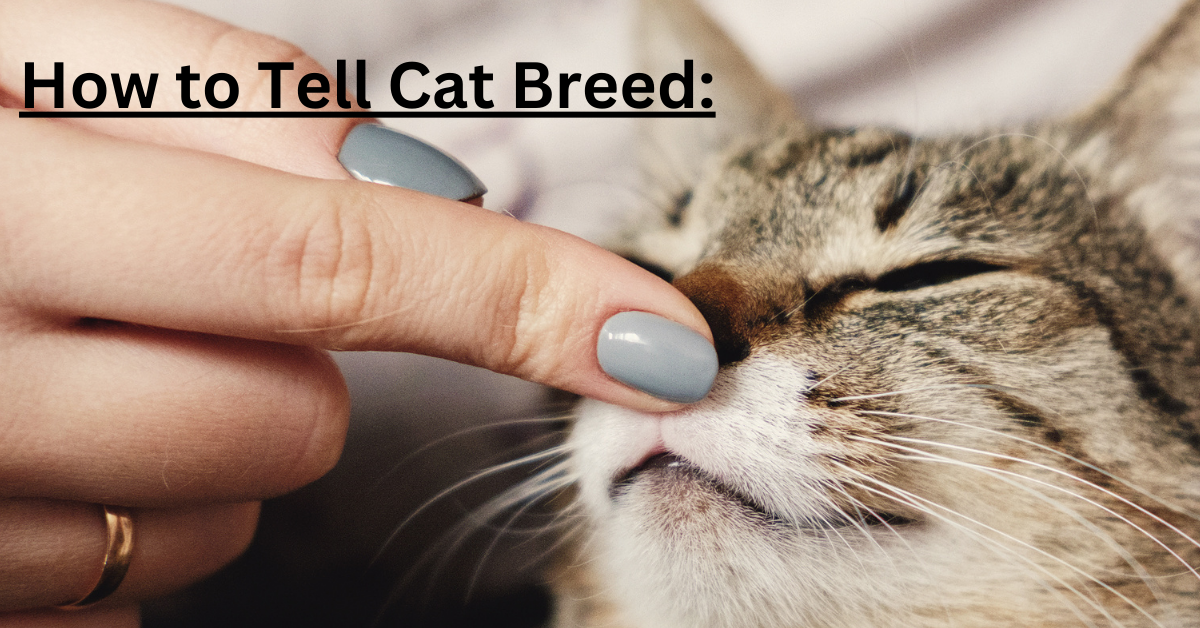How to Tell Cat Breed:If you’re a cat partner, you might have found yourself addressing almost your bushy pal’s breed. Be that as it may, with a sharp eye and a few essential understanding, you may learn how to tell cat breeds separated. In this direct, we’ll investigate various strategies and feature to offer assistance you decide your cat’s breed accurately.
Understanding Cat Breeds
Before digging into the specifics of figuring out cat breeds, it is fundamental to get it what constitutes a breed. A cat breed is a particular ancestry with uncommon real inclinations, behaviours, and each so regularly indeed personalities.
- Physical Characteristics: Cat breeds change broadly in estimate, shape, coat length, and colour designs. For case, the Maine Coon is known for its huge estimate and tufted ears, whereas the Siamese has a smooth body and striking blue eyes.
- Coat Sorts: Cats can have distinctive sorts of coats, such as short-haired, long-haired, curly-haired (e.g., Cornish Rex), or smooth (e.g., Sphinx). Each coat sort requires particular preparing needs.
- Temperament: Breed-specific personalities impact a cat’s conduct and compatibility with distinctive ways of life. For occasion, Rag-dolls are known for their resigned nature and warm aura, though Bengals are enthusiastic and playful.
- Origins and History: Understanding a breed’s roots can give experiences into its characteristics. A few breeds have old roots, like the Egyptian May, whereas others are generally cutting edge improvements, such as the Scottish Fold.
- Health Contemplation’s: Certain breeds are inclined to particular well being issues due to hereditary inclinations. For illustration, Persian cats may have respiratory and dental issues, whereas the Cloth doll breed might be vulnerable to hypertrophy cardiomyopathy.
- Activity Levels: Cats change in their movement levels and work out needs. Breeds like the Abyssinian are profoundly dynamic and require bounty of mental and physical incitement, while British Brief hairs are more inactive and appreciate calm companionship.
- Special Care Necessities: A few breeds require particular care. For occasion, breeds with level faces (encephalitic) like Persians may require offer assistance with preparing due to their thick coats, and smooth breeds like the Sphinx require customary skin care.
- Popularity and Acknowledged: Certain breeds are more prevalent and broadly perceived than others. The Cat Fanciers’ Affiliation (CF) and The Worldwide Cat Affiliation (TICS) are association that categorise and perceive different breeds based on particular standards.
- Compatibility with Proprietors: Finding a breed that matches your way of life and identity can improve the bond between you and your cat. Components such as vitality level, preparing needs, and socialisation necessities ought to be considered when choosing a breed.
- Ethical Contemplation’s: When selecting a cat breed, it’s imperative to consider moral concerns, such as dodging supporting breeders who propitiation benefit over the well being and welfare of the cats. Selection from covers and salvages is a compassionate elective.
key takeaways How to Tell Cat Breed:
- Physical Characteristics: See at the cat’s body shape, measure, coat length, and surface. Note any particular highlights like ear shape (e.g., collapsed ears in Scottish Folds) or tail length.
- Facial Highlights: Watch the shape of the cat’s confront, counting gag length, eye shape, and ear position.
- Coat Colo and Design: Take note of the cat’s coat colour (strong, dark-striped cat, calico, etc.) and any one of a kind designs (spots, stripes, points).
- Behavioural Characteristics: Whereas not conclusive, a few breeds have particular behaviours. For case, Siamese cats are known for their vocational.
- Genetic Testing: For exact recognisably proof, consider hereditary testing which can give understanding into the cat’s breed blend.
Identifying Cat Breeds

1. Coat Type
One of the most discernible capacities of a cat is its coat. Diverse breeds appear off assorted coat sorts, which incorporate brief, long, wavy, or smooth. For illustration, a feathery cat with a thick, triple-layered coat is likely a Maine Coon, indeed as a smooth, short-haired cat is likely an American Short hair.
2. Facial Structure
Pay pondering for your cat’s facial highlights, as they seem demonstrate its breed. A few breeds, like Persians, have level faces with brief noses, while Siamese cats brag particular almond-shaped eyes and triangular faces.
3. Body Proportions
Each cat breed has its one of a kind outline shape and length. A few breeds, broad of the slim Oriental Short hair, have long, exquisite bodies, while others, fair like the British Short hair, are known for his or her vigorous, adjusted body. Evaluating your cat’s outline extents allow you to find its breed more prominent correctly.
4. Tail feature
The frame, term, and hide design of a cat’s tail can offer valuable clues around its breed. For case, breeds fair like the Manx have actually brief or indeed tailless tails, while others, comprising of the Maine Coon, have long, shaggy tails. Pay pondering in your cat’s tail and look at it to breed measures to choose its lineage.
Characteristics of a Tail Feature
- Late Expansion: Tail highlights are regularly included late in the improvement cycle, regularly in reaction to client criticism, changing necessities, or modern advertise requests that were not at first anticipated.
- Non-Essential but Improving: These highlights are more often than not not basic to the centre usefulness of the computer program but are expecting to upgrade the client involvement, make strides ease of use, or give extra value.
- Iterative Improvement: They are a trademark of iterative improvement techniques where the item advances over time based on persistent input and iteration.
- Market-driven: Tail highlights regularly address particular speciality needs or rising patterns in the advertise that were not distinguished or organiser amid the starting arranging stages.
Importance of Tail Features
- Competitive Edge: They can give a competitive edge by tending to interesting client needs or separating the item from competitors.
- Customer Fulfilment: Tail highlights contribute to in general client fulfilment by illustrating responsiveness to client criticism and moving forward the ease of use or usefulness of the software.
- Flexibility and Flexibility: They permit the program to adjust to changing showcase conditions and advancing client desires without requiring a total update of the existing system.
Challenges of Executing Tail Features
- Resource Assignment: Including unused highlights late in the advancement cycle can strain assets, counting time, budget, and personnel.
- Integration Complexity: Integration of tail highlights into existing frameworks can be challenging and may require broad testing to guarantee compatibility and reliability.
- Risk of Scope Crawl: There is a hazard that including as well numerous tail highlights may grow the scope of the extend past its unique boundaries, driving to delays or taken a toll overruns.
Examples of Tail Features
- Enhanced Detailing: Including more bitty gritty or customisation announcing capabilities to a trade analytics device based on client requests.
- Additional Perfection Alternatives: Presenting modern topics or perfection alternatives in a computer program application to request to diverse client preferences.
- Extended Stage Back: Including compatibility with modern working frameworks or gadgets to extend the software’s advertise reach.
5. Behaviour and mood
A few breeds, fair like the lively and social Abyssinian, have brilliant identity propensities that set them separated from others. Note any special practices or slants your cat appears and inquire about comparing breeds to see capability suits.
Behaviour
Behaviour alludes to the activities or responses of an person in reaction to inner or outside boosts. It envelops everything from physical activities to verbal expressions and indeed non-verbal prompts such as facial expressions and body dialect. Human conduct is affected by a complex exchange of natural, mental, social, and natural factors.
- Biological Variables: These incorporate hereditary inclinations, brain chemistry, hormones, and by and large physical well being. For illustration, neurotransmitters like serotonin and dopamine play significant parts in controlling temperament and behaviour.
- Psychological Variables: Cognitive forms, identity characteristics, convictions, and past encounters essentially shape conduct. For occasion, somebody with a history of injury may show practices related to shirking or hyper vigilance.
- Social Variables: Connections, social standards, societal desires, and peer impact all contribute to forming conduct. Social setting can decide whether certain practices are seen as satisfactory or not.
- Environmental Components: The physical environment, counting get to to assets, financial conditions, and living circumstances, can moreover affect conduct. For illustration, stressors such as destitution or stuffing may impact conduct patterns.
Mood
Mood alludes to a delayed enthusiastic state that colours a person’s discernment of the world and their encounters. Not at all like feelings, which are transitory and regularly in reaction to particular boosts, dispositions can final for hours, days, or indeed longer. Dispositions can be impacted by organic, mental, and natural variables comparable to behaviour.
- Biological Impacts: Neurotransmitters and hormones play a pivotal part in controlling disposition. For occurrence, awkward nature in serotonin levels are connected to disposition disarranges like depression.
- Psychological Impacts: Thought designs, convictions, and adapting procedures can influence disposition. Cognitive behavioural treatment, for illustration, centres on recognising and altering negative thought designs to make strides mood.
- Environmental Impacts: Upsetting occasions, life changes, and day by day schedules can affect disposition. A strong social arrange or locks in in pleasurable exercises can elevate temperament, whereas unremitting stressors can lead to drawn out negative moods.
Interconnection
Behaviour and temperament are personally associated in a bidirectional relationship. How we carry on can impact our disposition, and our disposition can, in turn, influence our behaviour.
- Behaviour Influencing Temperament: Locks in in physical movement, honing mindfulness, or seeking after pastimes can move forward temperament by discharging endorphins and lessening push. Alternately, pulling back from social intelligent or locks in in hazardous practices can compound mood.
- Mood Influencing Conduct: A positive disposition may lead to more agreeable and profitable practices, whereas a negative temperament might result in crabbiness, dormancy, or withdrawal from exercises.
table for How to Tell Cat Breed:
| Physical Characteristic | Breeds |
|---|---|
| Short Hair, Robust Build | American Short hair, British Short hair, Exotic Short hair |
| Long Hair, Fluffy Coat | Persian, Maine Coon, Rag doll, Norwegian Forest Cat |
| Distinctive Ears (Large) | Scottish Fold, Sphinx |
| Distinctive Ears (Tufts) | Maine Coon, American Curl |
| Siamese-Style Body & Face | Siamese, Oriental |
| Distinctive Coat Patterns | Bengal (rosettes), Calico (tree-colour), Tabby (stripes) |
| Very Large Size | Maine Coon, Rag doll |
| Small to Medium Size | Abyssinian, Burmese, Russian Blue |
| Bobbed Tail | American Bobtail, Manx |
| Curled Tail | American Curl |
| Hairless | Sphinx, Peter bald |
FAQs About How to Tell Cat Breed
Q: Can mixed-breed cats be recognised utilising these methods?
Whereas it may be more challenging to recognise mixed-breed cats precisely, these strategies can still give important bits of knowledge into their heredity based on transcendent physical traits.
Q: Are there any hereditary tests accessible to decide a cat’s breed?
Yes, there are hereditary testing packs planned particularly for cats that can offer assistance recognise their breed legacy by examining DNA tests. Be that as it may, these tests may not continual be 100% accurate.
Q: Is it basic to know my cat’s breed?
Knowing your cat’s breed can be obliging for discernment its particular needs, practices, and potential well being concerns. In any case, it’s not essential for giving adores and cares to your hairy companion.
Conclusion
Descry your cat’s breed can be a beneficial delight in for any cat proprietor. Remember that at the same time as these procedures can be excellent, they will no longer ceaselessly result authoritative arrangements, particularly for combined-breed cats. Whether your cat is a purebred with papers or a dazzling mix of various heredity, each cat merits adore, pondering, and a warm lap to bend up on. So, incorporate the uniqueness of your cat accessory and appreciate the travel of revelation collectively.
